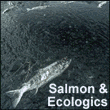forum
library
tutorial
contact

United Effort Fosters Fall Chinook
by StaffStatesman Journal, June 1, 2005
|
the film forum library tutorial contact |

|
United Effort Fosters Fall Chinookby StaffStatesman Journal, June 1, 2005 |
Tribe, officials release 40,000 salmon to boost species, fishing
Getting back on this comeback trail has taken more than two decades.
The past week, the first hatchery-raised fall chinook salmon were released into the Grande Ronde River in Washington.
It is part of an cooperative effort by Native American tribes and the Washington Department of Fish and Wildlife to help recover a threatened species and, ultimately, to contribute to future fishing.
Tanker trucks loaded with 400,000 nearly year-old fall chinook from the Lyons Ferry Hatchery drove to the release site on the river, a couple of miles downstream from the Oregon border.
Officials called the release a significant milestone in more than 20 years of cooperative efforts to increase the range and number of fall chinook in the lower Snake River basin, where they are listed under the federal Endangered Species Act as threatened with extinction.
Chipping into the effort are the Oregon, Washington and Idaho departments of Fish and Wildlife, members of the Nez Perce Tribe and Confederated Tribes of the Umatilla Indian Reservation, the U.S. Fish and Wildlife Service, Bonneville Power Administration and Idaho Power Company.
The release is the outgrowth of an agreement in U.S. vs. Oregon, a federal court case involving treaty-reserved fishing rights.
Through a proposal from officials of the Umatilla Tribes, the federal, state and tribal co-managers agreed to include Grande Ronde fall chinook releases in the Columbia River Fish Management Plan renegotiation agreement that was signed earlier this year.
"We've been envisioning this release nearly ever since Lyons Ferry Fish Hatchery was built to (make up for) fish loss from the Snake River dams," said Glen Mendel of Dayton, Wash., a district fish biologist.
The Grande Ronde River is a tributary of the Snake on the Washington-Oregon-Idaho border. It is located upriver from Lower Granite Dam, the last of the four dams on the lower Snake River in southeast Washington.
Snake River fall chinook juveniles also have been released from Lyons Ferry Hatchery at the hatchery in the Snake River near Captain John Rapids or Couse Creek. They also have been released from acclimation ponds operated by the Nez Perce Tribe in the Clearwater River, the Snake River at Pittsburgh Landing near Hells Canyon Dam, and at Captain John Rapids between Asotin and the mouth of the Grande Ronde River.
The releases of salmon are designed to make up for the four lower Snake River dams under the U.S. Fish and Wildlife Service Lower Snake River Compensation Program and Bonneville Power's Fish and Wildlife Program.
Fall chinook also have been released into the Clearwater River in Idaho from the 2-year-old hatchery operated by the Nez Perce to make up for loss of spawning areas caused by the construction of the Snake and Columbia River hydropower system, and by Idaho and Oregon at Hells Canyon Dam to make up for the operation of those dams by Idaho Power Company.
In all, more than 4 million juvenile chinook salmon -- including the 400,000 released into the Grande Ronde River -- will be released into the Snake River system this year.
Adult returns of both hatchery and naturally reproducing fish have increased significantly in recent years because of increased hatchery production and releases upstream of Lower Granite Dam, cuts in fishing in the lower river and ocean and improved ocean conditions, biologists said
Counts of fall chinook "redds" or nests in October through early December in the Grande Ronde were usually less than six a year in the late 1980s and early 1990s.
In the past few years, redds number in the hundreds, and even greater increases have been documented in the Snake and Clearwater rivers.
learn more on topics covered in the film
see the video
read the script
learn the songs
discussion forum
